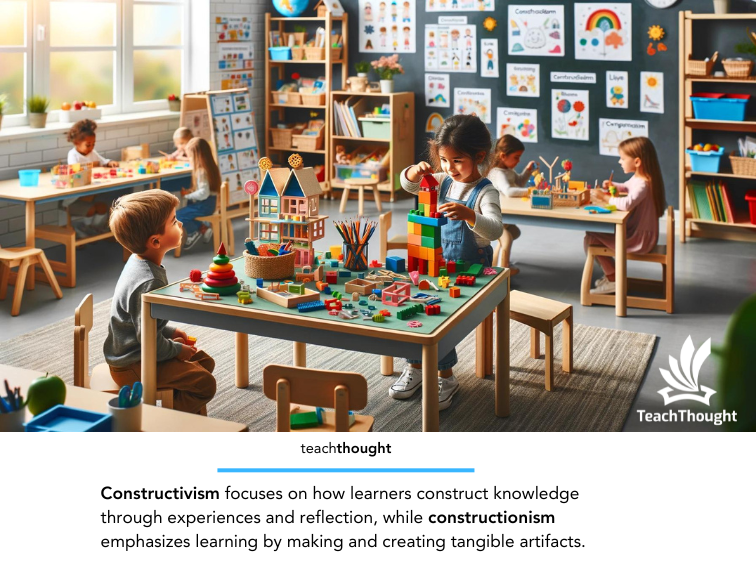By Terry Heick • Updated September 2025
Constructivism vs Constructionism: Definitions, Similarities, Differences
Definition of Constructivism
Core premise: Learners build understanding by integrating new experiences with prior knowledge in social and cultural contexts. The emphasis is on internal cognitive processes that organize and reorganize knowledge over time.
Influential theorists: Jean Piaget; Lev Vygotsky.
Key Elements
- Active learning: tasks require sense-making rather than passive reception.
- Knowledge construction: concepts are built and revised as evidence accumulates.
- Prior knowledge: existing schemas shape interpretation of new information.
- Social mediation: discourse, scaffolding, and cultural tools influence development.
- Contextuality: meaning depends on task, tools, community, and setting.
Brief Classroom Example
In an ecosystems unit, students investigate local samples, compare observations with references, then update concept maps after group discussion. The learning outcome is reorganization of conceptual relationships, not simple recall.
Definition of Constructionism
Core premise: Learning when when teachers have a chance to design and build personally meaningful, shareable artifacts and reflect on those creations in a community. The artifact functions as an object-to-think-with.
Influential theorist: Seymour Papert.
Key Elements
- Learning by making: building artifacts externalizes and stabilizes ideas.
- Project orientation: planning, prototyping, testing, and presenting.
- Reflection and iteration: critique cycles consolidate understanding.
- Computational media: programming, robotics, and fabrication as expressive tools.
- Personal relevance: choice and meaningful goals support persistence and depth.
Brief Classroom Example
In a data-literacy unit, students build simple sensor devices that log local environmental data, document design trade-offs, and present prototypes. Reasoning is surfaced through the artifact and its revisions.
Constructivism and Constructionism Compared
| Theme | Constructivism | Constructionism |
|---|---|---|
| Learner role | Learners actively build knowledge internally. | Learners build knowledge by making external, shareable artifacts. |
| Focus | Cognitive processes of assimilation and accommodation. | Design, creation, and iteration of tangible products. |
| Social interaction | Dialogue, scaffolding, and cultural context shape learning. | Peer critique and collaboration on artifacts reinforce learning. |
| Artifacts | Support understanding but are not central. | Serve as primary “objects-to-think-with.” |
| Assessment | Tracks conceptual change and knowledge reorganization. | Examines artifact quality alongside evidence of reasoning. |
In short: Constructivism explains how knowledge is built; Constructionism designs environments where making accelerates and externalizes that building.
Planning With These Theories
- Align tasks to clear goals; use Bloom’s Digital Verbs to calibrate cognitive demand.
- Use protocols and scaffolds to surface and reorganize prior knowledge.
- Design projects that culminate in shareable artifacts with critique and iteration.
- Collect varied evidence: artifacts, reflections, journals, concept maps, and conferences.
Continue Reading on TeachThought
References
- Piaget, J. (1952/1977). The Construction of Reality in the Child. Basic Books.
- Vygotsky, L. S. (1978). Mind in Society: The Development of Higher Psychological Processes. Harvard University Press.
- Papert, S. (1980). Mindstorms: Children, Computers, and Powerful Ideas. Basic Books.
- Papert, S., & Harel, I. (1991). Constructionism. Ablex Publishing.
- Ackermann, E. (2001/2004). Constructivism(s): Shared roots, crossed paths. MIT Epistemology and Learning Group papers.
- Bada, S. O. (2015). Constructivism learning theory: A paradigm for teaching and learning. Journal of Research & Method in Education, 5(6), 66–70.

